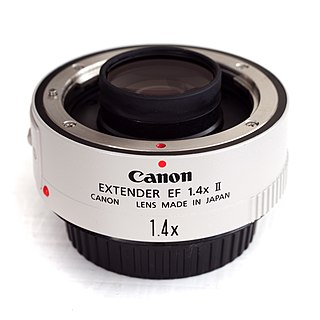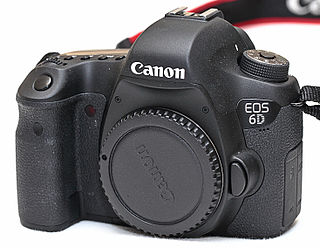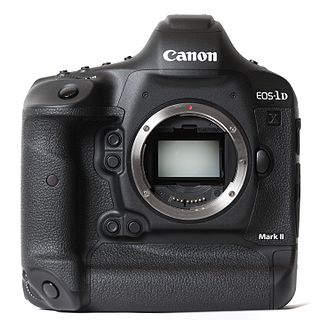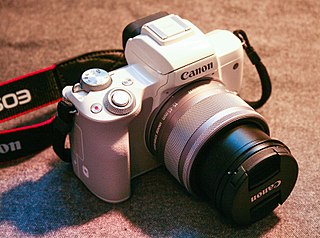
Canon EOS is an autofocus single-lens reflex camera (SLR) and mirrorless camera series produced by Canon Inc. Introduced in 1987 with the Canon EOS 650, all EOS cameras used 35 mm film until October 1996 when the EOS IX was released using the new and short-lived APS film. In 2000, the D30 was announced, as the first digital SLR designed and produced entirely by Canon. Since 2005, all newly announced EOS cameras have used digital image sensors rather than film. The EOS line is still in production as Canon's current digital SLR (DSLR) range, and, with the 2012 introduction of the Canon EOS M, Canon's mirrorless interchangeable-lens camera (MILC) system. In 2018 the system was further extended with the introduction of the EOS R camera, Canon's first full frame mirrorless interchangeable lens system.

The Canon EOS 5D is a 12.7 megapixel digital single-lens reflex (DSLR) camera body produced by Canon. The EOS 5D was announced by Canon on 22 August 2005, and at the time was priced above the EOS 20D but below the EOS-1D Mark II and EOS-1Ds Mark II in Canon's EOS digital SLR series. The camera accepts EF lens mount lenses.

The EOS 1D Mark III is a professional 10.1 megapixel digital single lens reflex camera (DSLR) camera body produced by Canon. The EOS 1D Mark III was announced on February 21, 2007 and is the successor of the Canon EOS-1D Mark II N and was first released in May 2007. In late 2009, the camera was succeeded by the Canon EOS-1D Mark IV. One of the main benefits of the new Mark III, over the previous models, was the added functionality of Live view, allowing users to take pictures while looking at an LCD screen. While it had the same outdated software as the older 1D series cameras, it had a much improved button layout, which is still used today. It also had improved wireless capabilities over the Mark II. The new WFT-E2 was much smaller than the previous WFT-E1 for the Mark II. The new transmitter could now also connect via a USB port. This allowed the optional addition of a GPS unit and wired PC connectivity.

The EOS-1Ds Mark III is a digital SLR camera body by Canon designed for professional photographers. The Canon EOS 1Ds Mark III is successor to the EOS-1Ds Mark II and was announced in August 2007. The camera features a full-frame 21.1 megapixel CMOS sensor with 14-bit analog/digital converters for a total colour depth of 16,384 tones per pixel. It features a three-inch (76 mm) LCD screen, capable of "Live View," and dual DIGIC III processors allowing it to shoot at up to five frames per second.

The Canon Extender EF lenses are a group of teleconverter lenses made by Canon. These lenses are used between any compatible EF type lens and any of the Canon EOS line of cameras. When used with a compatible lens, they will multiply the focal length of the lens by a factor of either 1.4x or 2x, at the cost of decreasing the lens' aperture by 1 or 2 stops respectively. For example, using a 1.4x or 2x extender with the Canon EF 500mm f/4L IS USM would result in a 700mm f/5.6 or 1000mm f/8 lens.

The Canon EOS 7D is a high-end APS-C digital single-lens reflex camera made by Canon. It was announced on 1 September 2009 with a suggested retail price of US$1,699, and was marketed as a semi-professional DSLR camera.

The EOS-1D Mark IV is a professional 16.1 effective megapixels digital single lens reflex camera (DSLR) camera body produced by Canon. The EOS-1D Mark IV is the successor of the Canon EOS-1D Mark III and was announced on 20 October 2009, just four days after Nikon announced the D3s. It used to be the only Canon APS-H format DSLR to feature HD video recording at 1080p resolution.

The Canon EOS 60D is an 18.1 megapixels semi-pro digital single-lens reflex camera made by Canon. It was announced on August 26, 2010, with a suggested retail price of US$1099.00. As a part of the Canon EOS two-digit line, it is the successor of the EOS 50D and is the predecessor of the EOS 70D.

The Canon EOS-1D X is a professional digital SLR camera body by Canon Inc. It succeeded the company's previous flagship Canon EOS-1Ds Mark III and the Canon EOS-1D Mark IV. It was announced on 18 October 2011.

The Canon EOS 6D is a 20.2-megapixel full-frame CMOS digital single-lens reflex camera made by Canon.

The Canon EOS 7D Mark II is a professional digital single-lens reflex camera made by Canon. It was announced on September 15, 2014 with a suggested retail price of US$1,799. It features a 20.2 effective megapixel APS-C CMOS sensor, Full HD video recording at 60 fps, 10.0 frames per second continuous shooting, a 100% accuracy viewfinder that offers 1× magnification. It also features a 65-point auto-focus system, a built-in Speedlite transmitter and a new 150k RGB pixels + IR metering sensor. It was preceded by the Canon EOS 7D.

The Canon EOS 5DS and EOS 5DS R are two closely related digital SLR cameras announced by Canon on February 6, 2015. Both are professional full-frame cameras with 50.3-megapixel sensors, the highest of any full-frame camera at the time of announcement. The only difference between the two models is that the sensor of the "R" version includes an optical filter that cancels out the effects of a standard optical low-pass filter. This distinction is roughly similar to that between Nikon's now-replaced D800 and D800E. Canon stated that both the 5DS and 5DS R will not replace the older EOS 5D Mark III; therefore, both the 5DS and 5DS R will have their new positions in Canon's DSLR camera lineup.

The Canon EOS 750D, known as the Rebel T6i in the Americas or as the Kiss X8i in Japan, is a 24.2 megapixels entry-mid-level digital SLR announced by Canon on February 6, 2015. As a part of the Canon EOS three-digit/Rebel line, it is the successor to the EOS 700D and the predecessor to the EOS 800D.

The Canon EOS-1D X Mark II was the company's 20-megapixel full-frame DSLR flagship camera, announced on February 1, 2016, by Canon with an MSRP of US$5,999.00. It is the successor to the Canon EOS-1D X, which was released in 2012.

The Canon EOS 5D Mark IV is a professional-grade 30.1-megapixel full-frame digital single-lens reflex (DSLR) camera made by Canon.

The Canon EOS 6D Mark II is a 26.2-megapixel full-frame digital single-lens reflex camera announced by Canon on June 29, 2017.

The Canon EOS 200D, known as the EOS Rebel SL2 in the Americas and EOS Kiss X9 in Japan, is a 24.2-megapixel upper entry-level midrange digital single-lens reflex camera made by Canon. It was announced on 28 June 2017, with a suggested retail price of US$549 for the body and US$699 with the Canon EF-S 18-55m f/4-5.6 IS STM lens. The European release price is significantly higher, at €599 for the body only, the equivalent of $671 at current conversion rates.

The Canon EOS M6 Mark II is a digital mirrorless interchangeable-lens camera announced by Canon on August 28, 2019, and released in September 2019. As with all of the Canon EOS M series cameras, the Canon EOS M6 Mark II uses the Canon EF-M lens mount. The M6 Mark II is the successor of both the M5 (2016) and the M6 (2017).

The Canon EOS M50 Mark II, also known as the EOS Kiss M2 in Japan, is a 24.1 megapixels entry-mid-level Mirrorless interchangeable-lens camera announced by Canon on October 14, 2020. As a part of their Mirrorless Canon EOS M Line, it is the successor to the Canon EOS M50, sitting above the entry-level Canon EOS M200 and below the enthusiast-oriented Canon EOS M6 Mark II.

The Canon EOS R3 is a 24 megapixel full-frame mirrorless interchangeable-lens camera launched by Canon officially announced by Canon on 14 September 2021 alongside two RF mount lenses. The camera is available as body only with a MSRP of US$5,999.00.




















